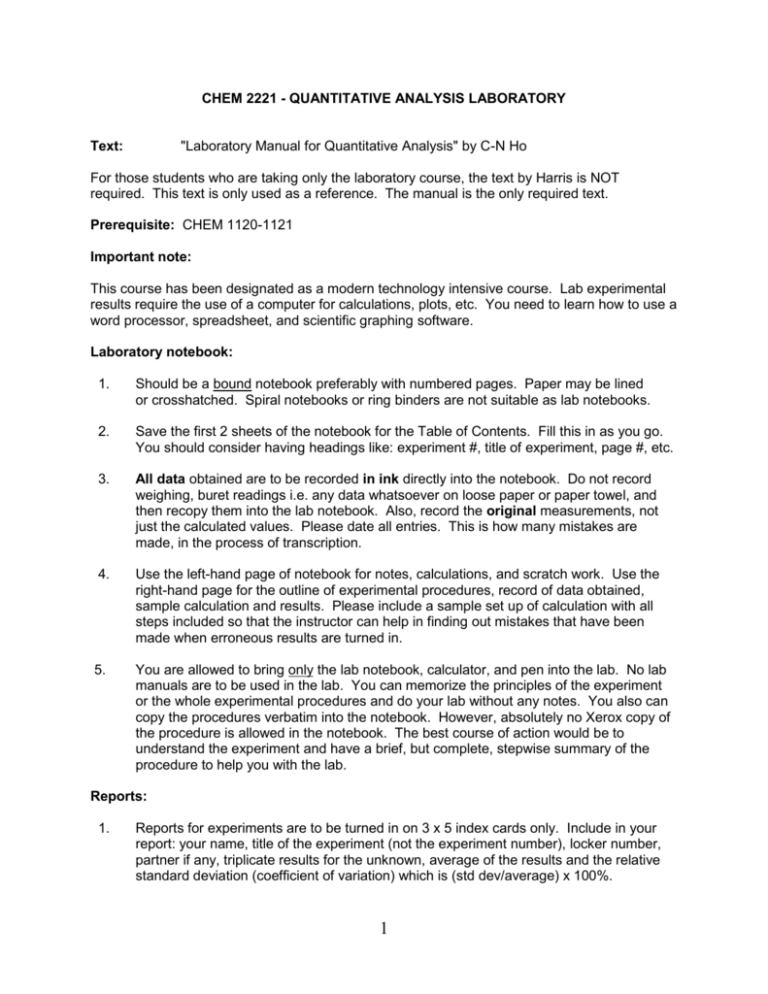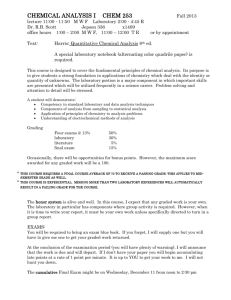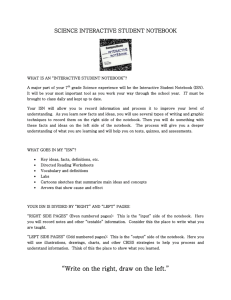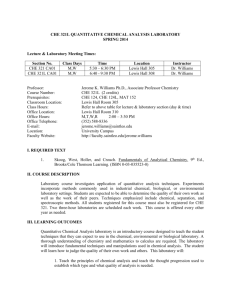CHEM 2221
advertisement

CHEM 2221 - QUANTITATIVE ANALYSIS LABORATORY Text: "Laboratory Manual for Quantitative Analysis" by C-N Ho For those students who are taking only the laboratory course, the text by Harris is NOT required. This text is only used as a reference. The manual is the only required text. Prerequisite: CHEM 1120-1121 Important note: This course has been designated as a modern technology intensive course. Lab experimental results require the use of a computer for calculations, plots, etc. You need to learn how to use a word processor, spreadsheet, and scientific graphing software. Laboratory notebook: 1. Should be a bound notebook preferably with numbered pages. Paper may be lined or crosshatched. Spiral notebooks or ring binders are not suitable as lab notebooks. 2. Save the first 2 sheets of the notebook for the Table of Contents. Fill this in as you go. You should consider having headings like: experiment #, title of experiment, page #, etc. 3. All data obtained are to be recorded in ink directly into the notebook. Do not record weighing, buret readings i.e. any data whatsoever on loose paper or paper towel, and then recopy them into the lab notebook. Also, record the original measurements, not just the calculated values. Please date all entries. This is how many mistakes are made, in the process of transcription. 4. Use the left-hand page of notebook for notes, calculations, and scratch work. Use the right-hand page for the outline of experimental procedures, record of data obtained, sample calculation and results. Please include a sample set up of calculation with all steps included so that the instructor can help in finding out mistakes that have been made when erroneous results are turned in. 5. You are allowed to bring only the lab notebook, calculator, and pen into the lab. No lab manuals are to be used in the lab. You can memorize the principles of the experiment or the whole experimental procedures and do your lab without any notes. You also can copy the procedures verbatim into the notebook. However, absolutely no Xerox copy of the procedure is allowed in the notebook. The best course of action would be to understand the experiment and have a brief, but complete, stepwise summary of the procedure to help you with the lab. Reports: 1. Reports for experiments are to be turned in on 3 x 5 index cards only. Include in your report: your name, title of the experiment (not the experiment number), locker number, partner if any, triplicate results for the unknown, average of the results and the relative standard deviation (coefficient of variation) which is (std dev/average) x 100%. 1 Student Name Locker Number TITLE OF EXPERIMENT Date 56.25% 56.91% 56.02% x = 56.39% SD = 0.46 RSD = 0.82% (0.46/56.39) x 100% 2. The report is due in the first lab period following your completion of the experiment. Turn in duplicate copies so that a graded copy can be returned to you. New unknown will not be issued if reports are considered delinquent. 3. The experiments are graded for accuracy and precision of results. These are indicators of preparedness, refined lab skill and techniques, and problem solving ability. Those contain graphs are graded similarly except that the quality of the graphs is 30% of score. 4. Repeat of an experiment, with a new unknown, is allowed if time permits. It is more important to get all the experiments completed first. If a graded "bad" analysis is the result of miscalculation (this, more often than not, is the cause of "bad" result), the analysis may be resubmitted. In either case, a 10% penalty is imposed. Thus the maximum score for the first repeat is 90%; the maximum score for the second repeat is only 80%. Noteworthy: 1. Everyone is to be done at the end of 3.5 hours. DO NOT begin any procedure that will not be completed 30 minutes prior to end of period to allow routine clean-up. 2. To complete all the experiments in the time allotted, plan ahead. Be prepared, understand the principles of the experiments and the required procedures. In the lab, find something to do, rather than waiting around for a sample to dissolve, heat up, etc. 3. The grade for the course will be determined in the following manner: Lab written exam, 20% Experiments, 80% In addition, up to 5% FROM THE FINAL SCORE may be deducted for repeated poor lab techniques, safety violations, poorly prepared notebook, do not record data directly into lab book, come in late and leave late, frequent demonstration of being lost and ill prepared, etc. Experiments: 1. Analysis of Impure Potassium Hydrogen (Acid) Phthalate 2. Determination of Chloride By Gravimetric Method 3. Complexometric Titration With EDTA For Determination of Water Hardness 2 4. Analysis of Iron Oxide Using Dichromate 5. Determination of Sodium Carbonate Content in Impure Soda Ash 6. Determination of Copper in Copper Oxide Samples by Iodometric Titration 7. Potentiometric Titration Determination of Acetic Acid in Commercial Vinegar -The following experiments are to be done in pairs -sign up for the dates you prefer to do experiments (see the approximate schedule of experiments to be done) -each of you need your own separate unknown 8. Spectrophotometric Determination of Iron Via Its 1,10-Phenanthroline Complex 9. Determination of Fluoride Ion Using a Fluoride Selective Electrode 3










